Early History of the Methodist Church
in
Montgomery, Texas
___________
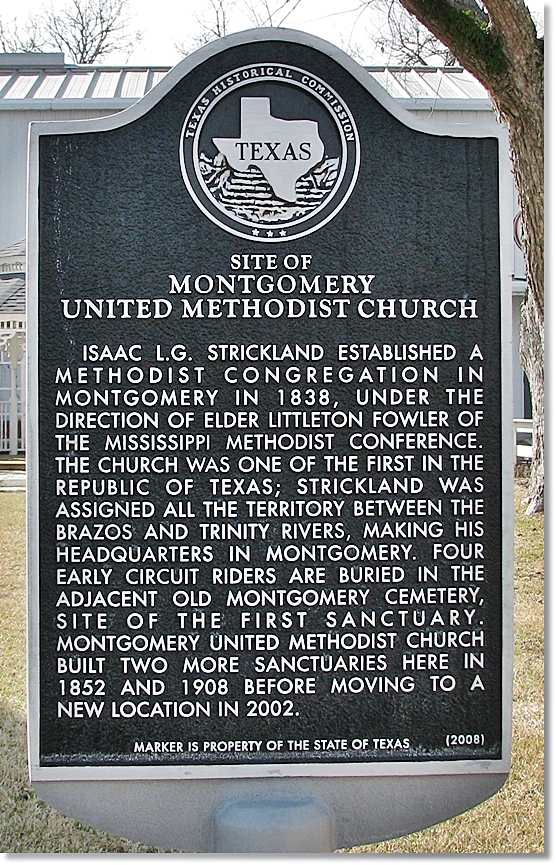
Marker Located in Front of the Old Methodist Church in Montgomery Texas
____________
Montgomery Methodist Church History
It is really quite amazing how much historical evidence still exists to tell us
the early history of the Montgomery Methodist Church in Montgomery, Texas. In fact, we are very blessed
in that the complete journal of the quarterly meetings for the Montgomery Circuit from 1839-1850
still exists. This is an amazing primary document that gives us many
important details of the early history of Methodism between the Brazos and Trinity Rivers and between the San
Antonio Road and San Felipe. It appears that this particular journal is so rare that it may even be
unique. In fact, many of the early historians of Texas Methodism appear to have relied heavily on this
particular document as a rare example of quarterly conference meetings as early as 138 years ago (Thrall,
1872).
Before going further, it is necessary to define what a "circuit" and a "circuit
rider" were. Joseph Anderson provides a number of useful definitions in his 1909 book entitled
A Brief Work on Methodist Terminology Prepared in the Interest of Ministers, Members and Friends of the
Methodist Episcopal Church, (New York, Eaton & Mains), page 24.
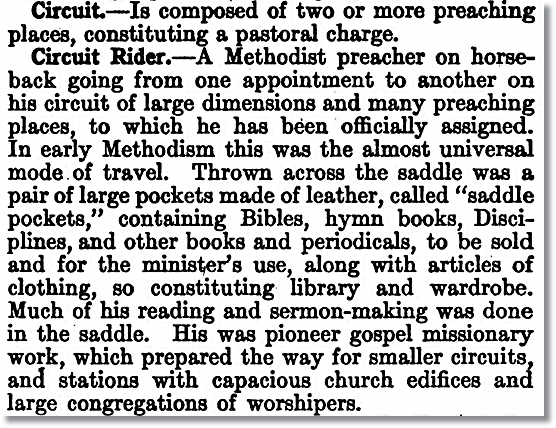
Montgomery Circuit and Circuit Riders
Circuit. - Is composed of two or more
preaching places, constituting a pastoral charge.
Circuit Rider. - A Methodist preacher on horseback going from one appointment to another on his
circuit of large dimensions and many preaching places, to which he has been officially
assigned. In early Methodism this was the almost universal mode of travel. Thrown across
the saddle was a pair of large pockets made of leather, called "saddle pockets," containing Bibles, hymn
books, Disciplines, and other books and periodicals, to be sold and for the minister's use, along with
articles of clothing, so constituting library and wardrobe. Much of his reading and sermon-making was
done in the saddle. His was pioneer gospel missionary work,
which prepared the way for smaller circuits, and stations with capacious church edifices and large
congregations of worshipers.

Pastoral Charge. - A local society, circuit, or station placed in official charge of a
minister.
See Joseph Anderson's 1909 book entitled A Brief Work on Methodist
Terminology Prepared in the Interest of Ministers, Members and Friends of the Methodist Episcopal Church,
(New York, Eaton & Mains), page 67.
Mississippi Conference
Originally, in 1838, the Montgomery Circuit was part of the Texas Mission District
which was part of the Mississippi Conference of the Methodist Episcopal Church. The Texas Conference of the
Methodist Episcopal Church would not be created until 1840.
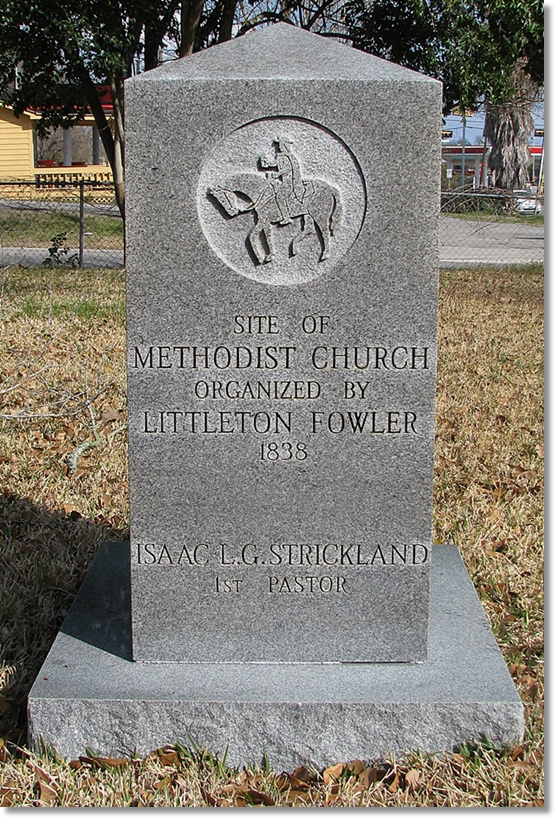
A Marker in the Old Methodist Cemetry in Montgomery Reads:
SITE OF METHODIST CHURCH
ORGANIZED BY LITTLETON FOWLER 1838
ISAAC L.G. STRICKLAND 1ST PASTOR
Preacher Appointments for 1839
Bottom of Page 52
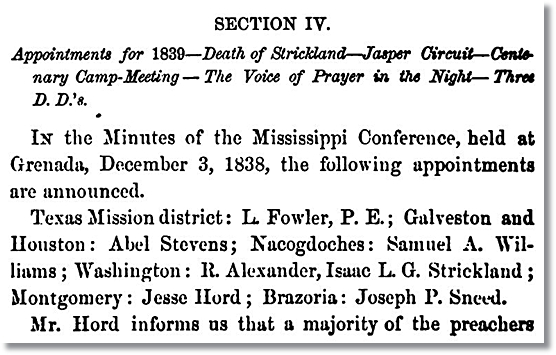
SECTION IV.
Appointments for 1839 - Death of Strickland - Jasper Circuit - Centenary Camp
Meeting - The Voice of Prayer in the Night - Three D.D.'s
In the Minutes of the Mississippi Conference, held at Grenada, December 2,
1838, the following appointments are announced.
Texas Mission district: L. Fowler, P.E.; Galveston and
Houston: Abel Stevens; Nacogdoches: Samuel A. Williams; Washington: R. Alexander,
Isaac L. G. Strickland; Montgomery: Jesse Hord;
Brazoria: Joseph P. Sneed.
Mr. Hord informs us that a majority of the preachers...
See Homer S. Thrall's book, History of Methodism in Texas, published in
Houston, Texas by E. H. Cushing in 1872, page 52. The preacher initially appointed to the Montgomery circuit
by the Mississippi Conference was Jesse Hord.
As we will see on page 53 of Thrall's book, Isaac L. G. Strickland, who was originally
assigned to the Washington circuit by the Mississippi Conference, would be re-assigned to the Montgomery circuit
instead of Jesse Hord. However, Strickland would not be the circuit preacher of the Montgomery circuit for
very long. Joseph P. Sneed would replace Strickland in March of 1839.
It is also very important to note that when the circuit preacher appointments
were announced for the Texas Mission District on December 3, 1838, there were only six Methodist circuit
preachers for the whole Republic of Texas. These men were missionaries being sent into Texas to begin
preaching Methodism at a rudimentary level. And, as we will see later, they were stretched very thin.
The Montgomery Circuit was created, but there were no churches in the Montgomery Circuit. The first church
would not be built until 1851.
Top of Page 53
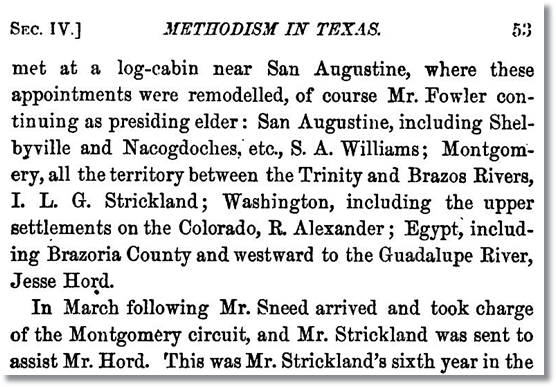
SEC. IV.]
METHODISM IN
TEXAS.
53
...met at a log-cabin near San Augustine, where these appointments were remodelled, of
course Mr. Fowler continuing as presiding elder: San Augustine, including Shelbyville and
Nacogdoches, etc. S. A. Williams; Montgomery, all territory
between the Trinity and Brazos Rivers, I. L. G. Strickland; Washington, including the upper
settlements on the Colorado, R. Alexander; Egypt, including Brazoria County and westward to Guadalupe
River, Jesse Hord.
In March following Mr. Sneed
arrived and took charge of the Montgomery circuit, and Mr. Strickland was sent to assist Mr. Hord.
This was Mr. Strickland's sixth year in the...
The Montgomery Circuit was huge, and included "all territory between the Trinity and
Brazos Rivers." Isaac L. G. Strickland would not be the circuit preacher for the Mongomery Circuit for
long. He was replaced by Joseph P. Sneed in March of 1839. Shortly after his replacement, Isaac
L. G. Strickland, the first Methodist preacher/missionary on the Montgomery circuit would die near
West Columbia on July 2, 1839.
As shown in the primary document below, Isaac L.G. Strickland made an appearance at
the first quarterly conference meeting of the Montgomery Circuit on February 25, 1839.
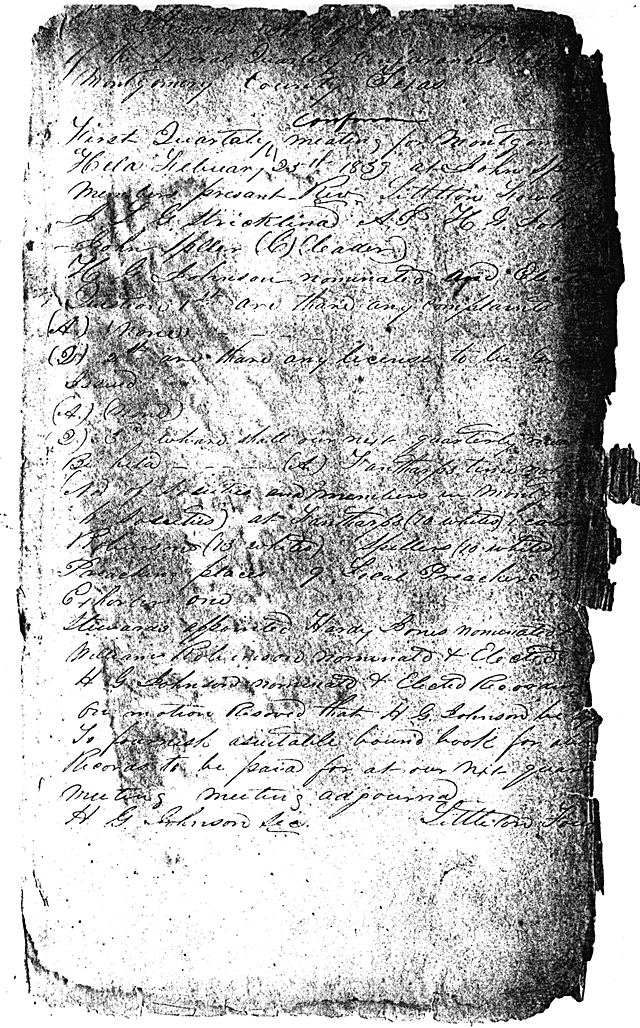
[Unreadble] Book of [unreadable]
of the Several Quarterly conferences held
Montgomery County, Texas
First Quarterly conference meeting for Montgomery
Held February 25 1839 at John Spillers
members present Rev. Littleton Fowler
I. L. G. Strickland A.P. H. G. Johnson
John Spiller (C) (leader)
H. G. Johnson nominated and elected
Question 1st are thare any complaints
(A.) (none)
(2) 2st are thare any license to be granted [or]
Issued
(A) (none)
(2) 3rd whare shall our next quarterly meeting
Be held - - - - - (A.) Fantharps time not
[unreadable]
(No) of Societies and members in Montgomery
6 Societies) at Fantharps (10 whites) 1 colored
Robinsons (13 whites) Spillers (10 whites)
Preaching places 9 Local Preachers
none
Exhorters One
Stewards appointed Hardy Jones nominated &
William Robinson nominated & Elected
H. G. Johnson nominated & Elected Recording
on motion Resoved that H. G. Johnson be [unreadable]
To fournish asuitable bound book for [unreadable]
Records to be paid for at our nxt quarterly
meeting meeting adjourned
H. G. Johnson
Sec Littleton
Fowler
See the first page of the "Journal of the church conference
held at Montgomery 1839-1850" located in the Oscar Murray Addison Papers in the Dolph Briscoe Center for
American History at the University of Texas at Austin [formerly the Barker Texas History Center] in Box
2A103. The first quarterly conference meeting of the Montgomery Circuit was held at John Spiller's on
February 25, 1839. Littleton Fowler, the Presiding Elder of the Texas Mission District, and Isaac L.G.
Strickland, the Circuit Rider/Preacher for the Montogmery Circuit were both present. The records of the
quarterly conference meetings were originally kept on sepearte sheets of paper until a book was obtained to
record the meetings. These sheets of paper are very rough around the edges but almost all of their
contents can still be read.
This was the infancy of the Methodist Epsicopal Church in the Montgomery
Circuit. In February of 1839, there were 6 Societies. Three of these Societies were mentioned by
name: Fantharps [Fanthorp's] Society, Robinsons Society and Spillers Society. There were 9 preaching
places. There were no Local Preachers. And there were, of course, no church buildings mentioned
anywhere in the Montgomery Circuit.
1839 Gustav Dresel's Houston Journal
Gustav Dresel wrote of people riding to "divine service" on horseback in his journal
while residing in Montgomery County in 1839:
"To deal with horses is learned very early by the young people of both
sexes, and it affords a peculiar sight to watch girls and boys riding with their books to school on
horseback. In the same manner people rode from the settlement
to Montgomery, the county seat where divine service was usually held on Sundays. Mrs. Rigby and
her women neighbors guided their horses as well as anyone of the cavalcade; nay, they often had a child
sitting in front of them on the horse's back and would take part in our wanton pell-mell riding on our way
home."
See Gustav Dresel's Houston Journal, Adventures in North America and Texas,
1837-1841, Translated by Max Freund, (1954, Austin, University of Texas Press), page 83. Though
an interesting anectdote, Dresel does not advise us which religious denomination's service he was attending
in this entry.
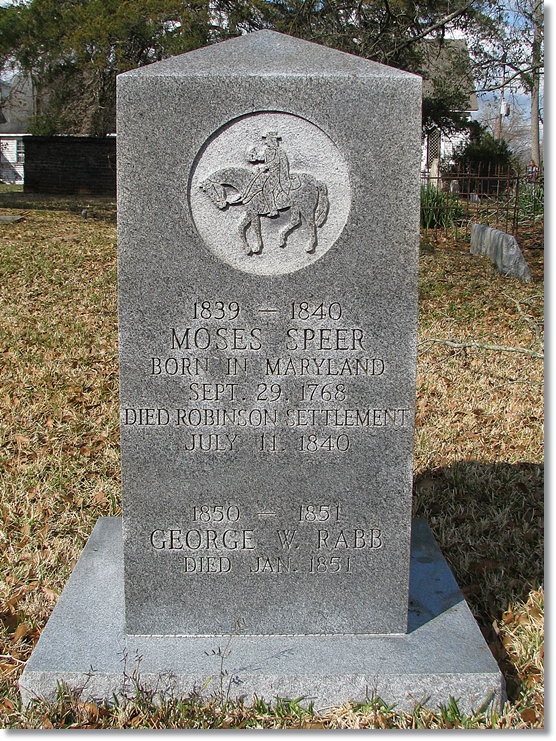
Marker reads in part:
1839-1840 MOSES SPEER
BORN IN MARYLAND SEPT. 29, 1768
DIED ROBINSON SETTLEMENT JULY 11, 1840
Preacher Appointments for 1840

SECTION V.
East Texas Appointments, 1840 - Dr. Baker's Narrative of Events in the East - Death
of Moses Spear
At the Mississippi Conference, held at Natchez, December 4th 1839, Texas
was divided into two districts: San Augustine district: L. Fowler, P.E.; San Augustine, S. A.
Williams; Jasper, Daniel Carl; Nacogdoches, Francis Wilson; Crockett, Henderson D.
Palmer; Montgomery, Moses Spear, Robert
Crawford; Houston, Edward Fountaine. Harrison to be...
In 1840, the Montgomery Circuit had two preachers: Moses Spear and Robert
Crawford. See Homer S. Thrall's book, History of Methodism in Texas, published in Houston, Texas
by E. H. Cushing in 1872, page 57. Robert Crawford would witness a couple of deeds in which land was
donated to build churches.
1840 Deed Records and Preacher Robert Crawford
The following abstract is from Deed Records for Montgomery County, Texas:
1835-1842: Volume F, (1993, Conroe, Montgomery County Genealogical & Historical Society), page
11. The deed is witnessed by Robert Crawford and regards the building of a place of worship for the
use of the members of the Methodist Episcopal Church. The abstract on page 11 reads:
Page
116-117
Deed
9 Sep 1840
JOSEPH LINDLEY and wife NANCY LINDLEY of the County of Montgomery of the 1st part and
JOHN SPILLER, SR., Abner HOUSEON, RICHARD DAVIDSON, WILLIAM H. HULON & JAMES SMITH, all of Montgomery
County & Republic of Texas witnesseth that Joseph and Nancy Lindley have given, grant and sell unto the
above named, land in Montgomery County in trust that they shall erect or build a place of worship for the
use of the members of the Methodist Episcopal Church. Wit: ROBERT CRAWFORD, R. H. OWEN.
We also find the abstract of another deed witnessed by Robt. Crawford on page 20
which also mentions the erection of a house of worship for the members of the Methodist Episcopal Church.
This deed is dated just a few days after (September 23, 1840) the one above (September 9, 1840).
Pages
180-181 Deed
23 Sep 1840
WILLIAM ROBINSON & ELIZABETH ROBINSON his wife of the one part and JAMES H.
COLLARD, JACOB MATHEWS, JOSHUA ROBBINS & GEORGE ROBINSON, trustees in trust for the use and purposes of
erecting a house or place of worship for use of the members of the Methodist Episcopal Church on 30-1/2
acres of land. /s/ William Robinson, Elizabeth (her mark) Robinson. Wit: H.W. HALL, ROBT. CRAWFORD.
Neither of the these early deeds describes land for the Methodist
church in the town of Montgomery. Though this land was transferred in 1840, it appears the first church to
be built in the Montgomery Circuit would be the one built in the town of Montgomery in 1851.
Preacher Appointments for 1841
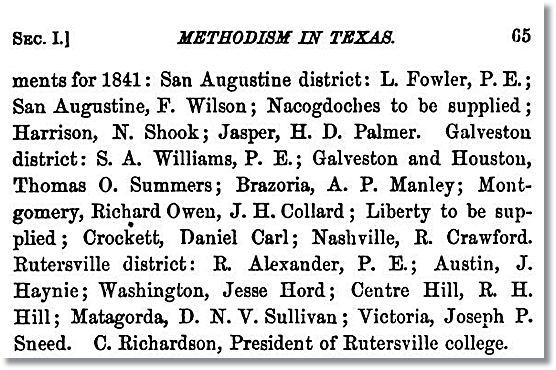
[The following were the appoint-]ments for 1841: San Augustine district: L.
Fowler, P.E.; San Augustine, F. Wilson; Nacogdoches to be supplied; Harrison, N Shook; Jasper, H.
D. Palmer. Galveston district: S. A. Williams, P. E.; Galveston and Houston, Thomas O Summers;
Brazoria, A. P. Manley; Montgomery, Richard Owen, J. H.
Collard; Liberty to be supplied; Crockett, Daniel Carl; Nashville, R. Crawford.
Rutersville district: R. Alexander, P. E.; Austin, J. Haynie; Washington, Jesse Hord;
Centre Hill, R. H. Hill; Matagorda, D. N. V. Sullivan; Victoria, Joseph P. Sneed. C.
Richardson, President of Rutersville college.
In 1841, the Montgomery Circuit had two preachers: Richard Owen and J. H.
Collard. See Homer S. Thrall's book, History of Methodism in Texas, published in Houston, Texas
by E. H. Cushing in 1872, pages 64-65. J. H. Collard had been in the rear guard at the Battle of San
Jacinto and was recruited as a preacher in the Montgomery Circuit where he lived.
January 6, 1841 Telegraph and Texas Register
Thrall's information regarding the 1841 appointments from his History of
Methodism in Texas (see above) is confirmed by this newspaper article that appeared in the
Telegraph and Texas Register on January 6, 1841.
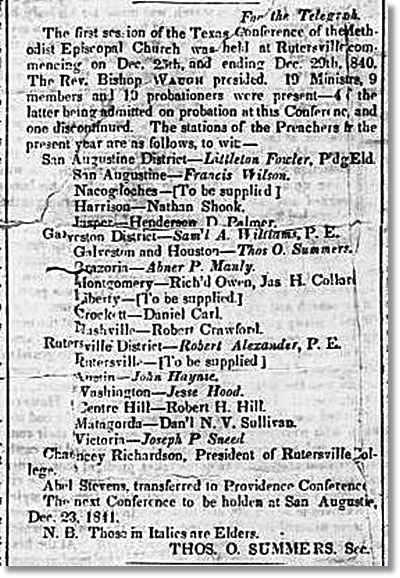
For the Telegraph
The first session of the Texas Conference of the Methodist Episcopal
Church was held at Rutersville commencing on Dec. 25th, and ending Dec. 29th, 1840. The Rev.
Bishop Waugh presided. 19 Ministers, 9 members, and 10 probationers were present - 4 0f the latter being
admitted on probation at this Conference, and one discontinued. The stations of
the Preachers for the present year are as follows, to wit:-
San Augustine District - Littleton Fowler, P'dg.
Eld.
San Augustine - Francis Wilson.
Nacogdoches - [To be supplied]
Harrison - Nathan Shook.
Jasper - Hendersen D. Palmer.
Galveston District - Sam'l A. Williams, P.E.
Galveston and Houston - Thos O. Summers.
Montgomery - Rich'd Owen , Jas H.
Collard.
Liberty - [To be supplied]
Crockett - Daniel Carl.
Nashville - Robert Crawford.
Rutersville District - Robert Alexander, P.E.
Rutersville - [To be supplied]
Austin - John Haynse. [Haynie]
Washington - Jesse Hood. [Hord]
Centre Hill - Robert H. Hill.
Matagorda - Dan'l N.V. Sullivan.
Victoria - Joseph P. Sneed.
Chauncey Richardson, President of Rutersville College.
Abel Stevens, transferred to Providence Conference.
The next Conference to be holden at San Augustine, Dec. 23rd,
1841.
N.B. Those in Italics are Elders.
THOS. O. SUMMERS, Sec.
The two circuit preachers on the Montgomery Circuit in 1841 were Richard Owen and
James H. Collard.
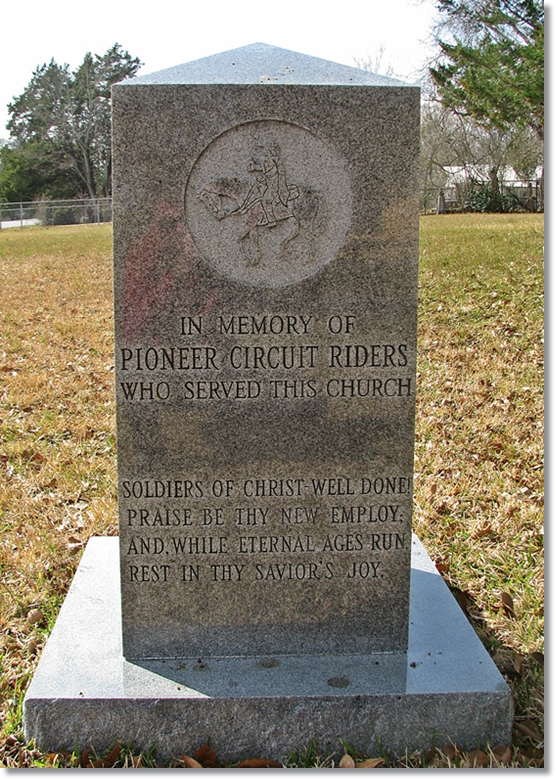
IN MEMORY OF PIONEER CIRCUIT RIDERS WHO SERVED THIS CHURCH
SOLDIERS OF CHRIST WELL DONE! PRAISE BE THY NEW EMPLOY;
AND, WHILE ETERNAL AGES RUN, REST IN THY SAVIOR'S JOY
Preacher Appointments for 1842
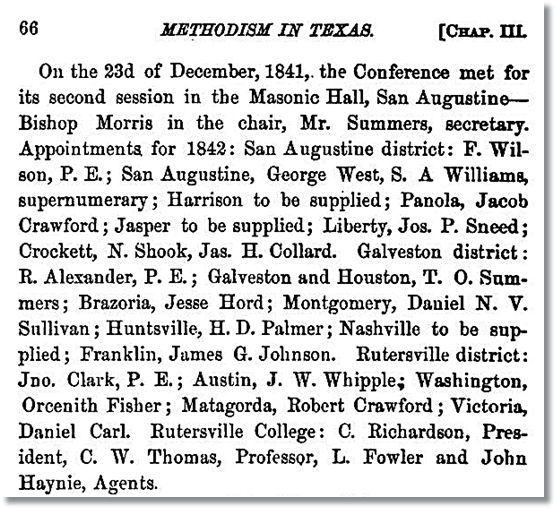
In 1842, the Montgomery Circuit had one preacher, Daniel N. V. Sullivan. See
Homer S. Thrall's book, History of Methodism in Texas, published in Houston, Texas by E. H. Cushing in
1872, pages 64-65.
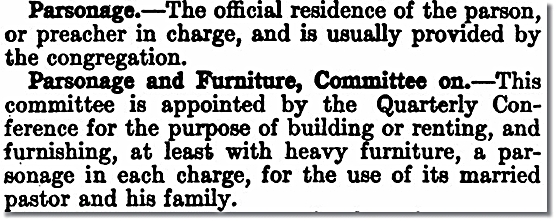
Parsonage, - The official residence of the parson, or preacher in charge, and is
usually provided by the congregation.
Parsonage and Furniture, Committee on. - This committee is appointed by the quarterly
Conference for the purpose of building or renting, and funishing, at least with heavy furniture, a parsonage
in each charge, for the use of its married pastor or his family.
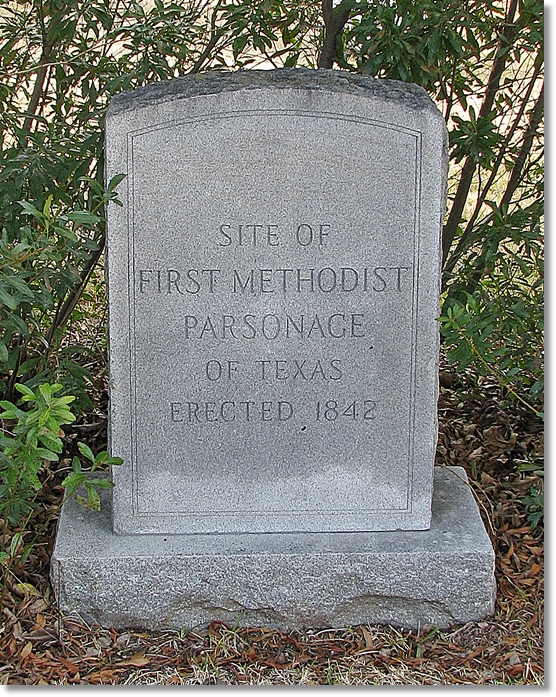
Marker reads:
SITE OF FIRST METHODIST PARSONAGE OF TEXAS ERECTED 1842
1842 Methodist Parsonage for "Montgomery Circuit"
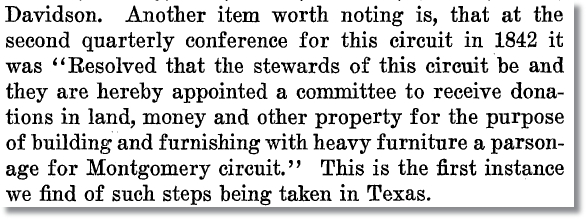
...Davidson. Another item worth noting is, that at the second quarterly conference for
this circuit in 1842 it was "Resolved that the stewards of this circuit be and they are hereby appointed a
committee to receive donations in land, money and other property for the purpose of building and furnishing
with heavy furniture a parsonage for Montgomery circuit."
This is the first instance we find of such steps being taken in Texas.
See Macum Phelan's A History of Early Methodism in Texas 1817-1866,
(1924, Nashville, Cokesbury), page 201. Where this parsonage was to be built (town of Montgomery or
somewhere else) is not stated here. It just says "a parsonage for Montgomery
circuit." The "Journal of the church conference held at Montgomery 1839-1850" in Box
2A103 in Oscar Murray Addison Papers at the Dolph Briscoe Center for American History at the
University of Texas at Austin has shed some very interesting light on the parsonage in the Montgomery
Circuit. The first parsonage was not built in 1842 and the first parsonage was not built in
Montgomery.
Preacher Appointments for 1843
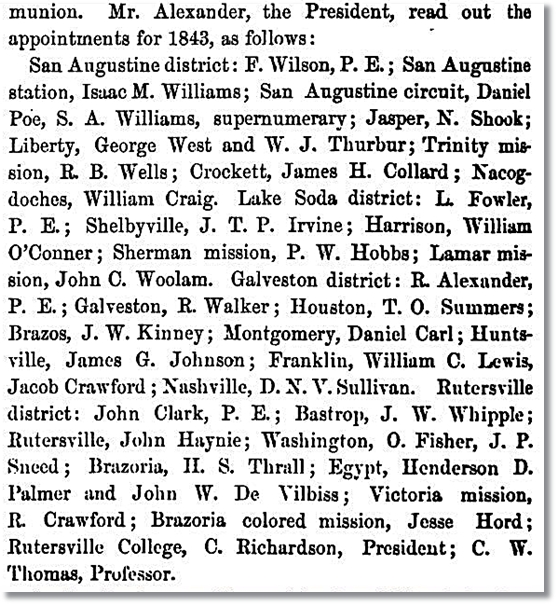
The circuit preacher assigned to the Montgomery circuit in 1843 was Daniel Carl.
See Homer S. Thrall's book, History of Methodism in Texas, published in Houston, Texas by E. H. Cushing
in 1872, page 70.
January 11, 1843 Telegraph and Texas Register
Homer Thrall's information regarding the 1843 preacher appointments from his
History of Methodism in Texas (see above) is confirmed by this newspaper article that appeared in
the Telegraph and Texas Register on January 11, 1843.
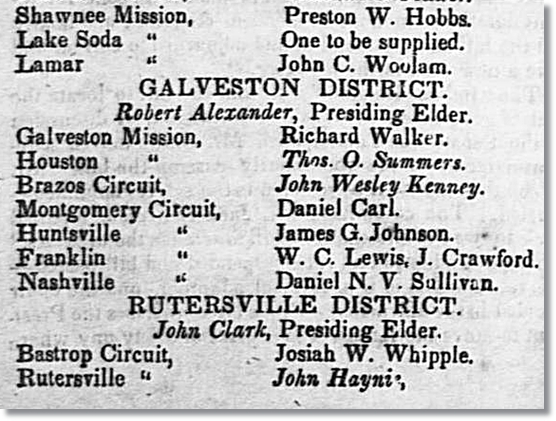
GALVESTON DISTRICT.
Robert Alexander, Presiding Elder.
Galveston
Mission, Richard Walker.
Houston
"
Thos. O. Summers.
Brazos Circuit,
John Wesley
Kenney.
Montgomery Circuit
Daniel Carl.
Huntsville
" James G.
Johnson.
Franklin
" W. C. Lewis, J.
Crawford.
Nashville
" Daniel N.V.
Sullivan.
See the January 11, 1843 edition of the Telegraph and Texas Register,
page 2. The circuit preacher appointed for the Montgomery Circuit in 1843 was Daniel Carl.
[KKS add circuit preacher appointments for 1844 - 1851 here]
Societies in the Montgomery Circuit
Until 1851, there were no churches, i.e. houses of worship, built anywhere in the
Montgomery circuit. When Strickland originally arrived in the Montgomery Ciruit, he was referred to
as a "missionary" because there were not very many Methodists or people of any faith in the Montgomery
circuit. Many of these people were frontiersmen who had always been a couple of steps ahead
of organized religion.
As an example, Tom Parmer, who for many years was an overseer for Sam Houston during
the 1840's1, wrote the following history for Thrall's History of Methodism in Texas.
See pages 151-154. Thrall describes Tom Parmer's appearance at the dedication of St. John's Methodist
Church in Galveston, Texas on February 12, 1871 and then continues in Tom Palmer's own words. Parmer
also gives an excellent account of an early Methodist camp-meeting:
In the dense crowd of whorshippers that assembled in St. John's to attend the
dedication services, might have been seen a venerable man walking up the left-hand aisle. He was as
straight as an arrow, six feet high, and his head as white as cotton. His apparel was plain, and
contrasted singularly with that of the mass of elegantly dressed people.
We question if there was a more attentive listener or devout worhipper in the splendid
house than he in homely garments. Watching him as he left the house, it would be seen that he had a
wary, cautious step, and was carefully attentive to every sound reaching his ear. That is the habit of
early life, acquired during forty years in which he had lived upon the extreme frontier, surrounded by
Indians and perils incident to such life. Those of our readers who are old Texans will recognize the
portrait we have drawn of Tom Parmer. We have endeavored to form an idea of Brother Parmer's
sensations as he entered that temple, with its tower and bell, the light streaming through its stained
windows and falling upon the rich furniture, the cushioned pews, and gorgeously carpeted floor, and
contrasted the appearance of that altar and its surroundings with the one at which he made a profession of
religion. Tom Parmer, as a representative frontiersman, shall have the privilege, of
telling his experience to our readers in his own language:
"I was raised, until fifteen, in the wilderness in the upper part of the State of
Missouri. Our nearest neighbors were the Sioux and Osage Indians; we had to fight them
often. During this time I never heard anything of religion, save I heard an old Hard-Shell Baptist
preach, who, I was for years confident, was John the Baptist that I had heard of. My father moved
to Texas in 1825. Soon after this I was in Allen's Settlement in Louisiana, where, for the first
time, I heard of the Methodists. Noisy and frolicsome, as I had heard, the outside appearances
pleased me, for I was all fun: war whoops, war-dances, and Indian-killing was the most I knew. But
to return. I went to the Methodist camp-meeting on Flatlick, prepared for a frolic; but when I
expected to hear the favorite war-whoop, I heard a sound I had never heard before. It seemed
a voice from a tomb, all sweetend with love. I stopped my horse and looked around. All I saw
looked sorry for me, and I was sorry for myself; and then it struck me, if that is Methodism they are
playing a game I never played. I had not yet hove in sight of the preacher, though I drew nearer,
and was in hopes the sainted voice would become funny, but not the case. I saw old Father Henry
Stevenson standing in a box talking to the people, who seemed charmed with what he was saying; but I
paid no attention to anything but the voice. I was then sixteen; had never heard a chapter read or a
sermon preached, save the one I thought was John the Baptist. I could not read, and did not know
there ever was or had been a Saviour. I got down and took my seat on a log some distance from the
preacher. I felt that I was in the wrong box. I would occasionally see the face of the
speaker, and there seemed to be something on it; he seemed to be the most honest man I had ever
seen. I would have given him my bottom dollar and Old Roan [his horse] if he had asked it.
By this time something ailed me, but I did not know what. An old gentleman came to me and asked me
if I would take a walk? I told him, gladly, for I thought there was a funny crowd out where he was
going, and that would suit me better. I began to cheer up, and would occasionally use a bad word,
at which the old man would groan. It struck me he was sick, and I did not feel well myself, but we
had not gone far until he fell on his knees. I saw he had not fainted, and nobody had shot
him. I was astonsihed; he said something I did not understand. When he got up I asked, 'What
are you?' 'A Methodist' 'What have you been doing?' 'Praying.' 'Does anyone pray
but Methodists?' 'Anyone can pray.' 'Can I pray?' 'Yes' 'Why did you not tell me
before, for I must do something; I have felt bad ever since I saw that man in the box.' I told him
I would go back and hear him make his next speech, which I did, and in his sermon understood something of
the plan of salvation. At the close of his sermon he invited all who wanted religion to go to the
mourners' bench. I went, of course. This was the first mourners' bench I had ever
seen. It was a split log with legs in it; the ends were east and west. I knelt, with my face
towards the north. I felt sick, and not sick either. There came round a brother and told me
to give up all to God. I told him I had nothing but Roan, and he was welcome to him if he wanted
him. The brother told me my error; I then began to try to say, 'Not my will, but thine be
done.' An hour afterward I suddenly felt that I was in the middle of a dark world, in the middle
of a dark room, on my kees on a black pile of powder, and it flashed, and I went up with it. I
then found out what was on the old preacher's face; it was glory! It was on everything I could
see. The trees, the ground, the people, all seemed glorious. Brother, you know how I felt; I
felt glorious; and even now, while I write I can hardly stand it. I felt glorious and triumphant
in my blessed Saviour. I began to meditate, to see if I could understand why I was so happy.
I first hought I was mistaken in the boy; it was not Tom, it was somebody else. After close
examination I could not decide until I recollected I had mashed my finger-nail not long before, and
there was a white speck under the nail if it was Tom. I looked and it was there. Then I
traced the finger to the hand, and along the arm to the body, and found it was Tom Parmer, and shouted,
'Glory! Glory!' The next morning Father Stevenson gave me a Bible and hymn-book, with these
words: 'Take these, my son, and be faithful.'"
Young Parmer started for his Texas home singing two verses of "Jesus, my all, to heaven
has gone," the only hymn he had learned. He at once commenced holding prayers in his father's
family. Five years after, Henry Stevenson visited Texas. His young friend had learned to read
the Bible, and was still faithful. At Mr. Teel's, where Father Stevenson preached, young Parmer formed
the acquaintance of Miss Rachel Teel, who was not then a professor of religion, and had from some causes
failed to hear preaching. He says of her, "I thought she would suit me if she had religion, and I
thought it was only necessary for her to hear Father Stevenson preach to make her religious. Not long
afterward he had an appointment to preach on Bayou Sara, La. This young lady and another and myself
went to hear him. We had to ride twenty miles the last morning before preaching. Father
Stevenson was just taking his text as we got in. It was 'Martha, thou art careful and troubled about
much serving,' etc. The two young ladies were quite gay. They had got hold of some starch that a
merchant had brought to Texas, and used some, and felt exalted. 'But Mary has chosen the good part
which shall not be taken away from her.' Father Stevenson had got about half through his sermon when
he took the starch out of the girls, and they both cried aloud for prayer, and were soon converted.
Rachel and I fixed up things at once. I was now a married Methodist, with a Methodist
wife."
Mr. Parmer settled near Sabine Bay, and in 1834 Father Stevenson visited him and
preached in his house. subsequently he lived in Walker Co., and was a near neighbor to Gen. Sam
Houston. Gen. Houston often declared that the conversations and prayers of Tom Parmer had been of
unspeakable advantage to him when he was seeking religion. The old General, as is well known, after he
professed religion united with the Baptist church. After various moves, Mr. Parmer and his excellent
wife are now residents of Galveston Island, and worshippers in St. John's Church.
Until 1851, there were only societies in the Montgomery Circuit.
As people within the Montgomery Circuit converted to Methodism, they formed "societies." These
societies were Methodist believers in a particualr neighborhood, settlement or community. These societies
were intially very small. The societies would meet for the Sabbath at people's houses or in other
buildings which were not churches. Between 1839 and 1851, there were no churches (houses of worship built
exclusively for the purpose) in the Montgomery Circuit. The first building built to be a church or house
of worship in the Montgomery Circuit was Alexander Chapel in Montgomery in 1851.
Below is a list of the societies listed in the "Journal of the church conference
held at Montgomery, Texas, 1839-1850." Again we find no mention of any churches in the "Journal of the
church conference held at Montgomery, Texas, 1839-1850."
[List Societies in the Montgomery Circuit here]
1850 Texas Conference

The eleventh session of the Texas Conference was held at Richmond from
December 11 to 16, 1850, with Bishop Andrew presiding, and Chaucey Richardson as Secretary....
See Macum Phelan's A History of Early
Methodism in Texas 1817-1866, (1924, Nashville, Cokesbury), page 321. The following are the
appointments made at this conference for the Rutersville District:
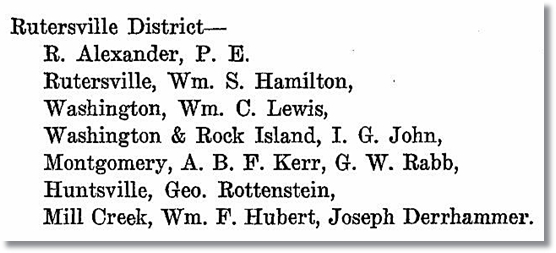
Rutersville District
R. Alexander, P. E. [Presiding Elder]
Rutersville, Wm. S. Hamilton,
Washington, Wm. C. Lewis,
Washington & Rock Island, I. G. John
Montgomery, A. B. F. Kerr, G. W.
Rabb,
Huntsville, Geo. Rottenstein,
Mill Creek, Wm. F. Hubert, Joseph Derrhammer.
See Macum Phelan's A History of Early Methodism in Texas 1817-1866,
(1924, Nashville, Cokesbury), page 322-323. The 1851 appointments for Montgomery were A. B. F. Kerr and G.
W. Rabb.

The bottom of this marker in the Old Methodist Cemetery in Montgomery reads:
1850 - 1851
GEORGE W. RABB
DIED JAN. 1851
Rabb does not appear to have lived long after his appointment. This marker in
the Old Methodist Cemetery in Montgomery, Texas indicates that he died in January of 1851. However, Homer
S. Thrall indicates a death year of 1850 for G. W. Rabb.
Town of Montgomery Gets a Stationed Methodist Preacher
The above is the official list, as published in the General Minutes, but it is
incomplete. In the appointments as they appear in the Texas Wesleyan Banner, following the
conference, are the following additions: C. Richardson, editor of the Banner; a Montgomery station appears with Jas. G. Johnson in
charge,..."
With the appointment of James G. Johnson, the Methodists in the town Montgomery would
no longer have to rely on circuit preachers to occasionally come through. Prior to his appointment as the
stationed preacher in the town of Montgomery, James G. Johnson had been circuit preacher for the
Montgomery Circuit in 1845.
Alexander Chapel Dedicated in Montgomery, Texas in 1851
Below is an article written by C. Richardson in July of 1851 regarding
the dedication of the Methodist Church in Montgomery, Texas. This is the earliest record of a Methodist
Church building for worship being built in Montgomery that we have located so far. If you have a primary
record referring to an earlier church building for worship, please let us know.
Bottom of Page 236
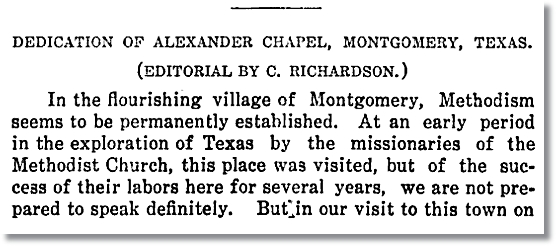
All of Page 237
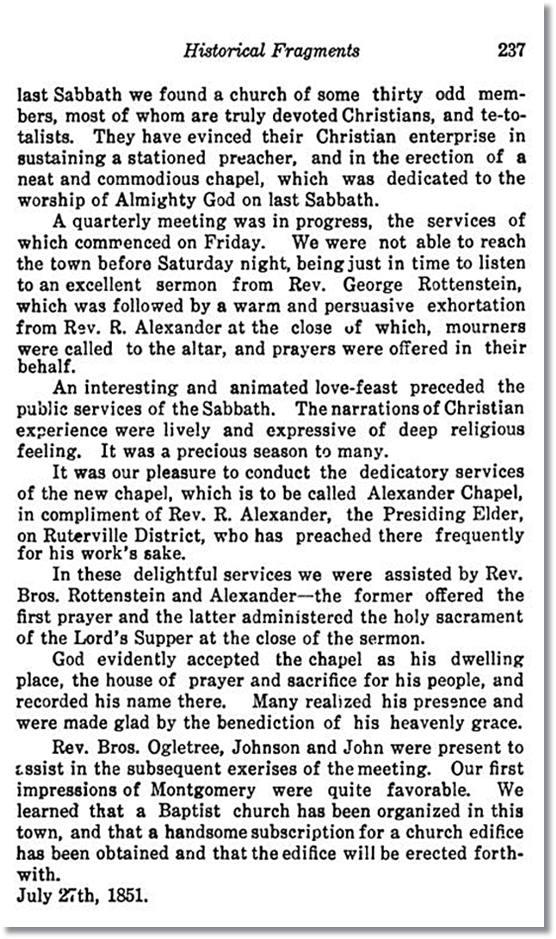
DEDICATION OF ALEXANDER CHAPEL, MONTGOMERY, TEXAS.
(EDITORIAL BY C. RICHARDSON)
In the flourishing village of Montgomery, Methodism seems to
be permanently established. At an early period in the exploration of Texas by missionaries of the
Methodist Church, this place was visited, but of the success of their labors here for several years, we are not
prepared to speak definitely. But in our visit to this town on
last Sabbath we found a church of some thirty odd members, most of whom are truly devoted Christians,
and te-totalists. They have evinced their Christian enterprise in
sustaining a stationed preacher, and in the erection of a neat and commodious chapel, which was dedicated to
the worship of Almighty God on last Sabbath.
A quarterly meeting was in progress, the services of which
commenced on Friday. We were not able to reach the town before Saturday night, being just in time to
listen to an excellent sermon from Rev. George Rottenstein, which was followed by a warm and persuasive
exhortation from Rev. R. Alexander at the close of which, mourners were called to the altar, and prayers were
offered in their behalf.
An interesting and animated love-feast preceded the public
services of the Sabbath. The narrations of Christian experience were lively and expressive of deep
religious feeling. It was precious season for many.
It was our pleasure to conduct the dedicatory services of
the new chapel, which is to be called Alexander Chapel, in compliment
of Rev. R. Alexander, the Presiding Elder, of the Ruterville District, who has preached there frequently
for his work's sake.
In these delightful services we were assisted by Rev. Bros.
Rottenstein and Alexander-the former offered the first prayer and the latter administered the holy
sacrament of the Lord's Supper at the close of the sermon.
God evidently accepted the chapel as his dwelling place, the
house of prayer and sacrifice for his people, and recorded his name there. Many realized his presence and
were made glad by the benediction of his heavenly grace.
Rev. Bros. Ogletree, Johnson and John were present to assist in the subsequent exerises of the
meeting. Our first impressions of Montgomery were quite favorable. We learned that a
Baptist church has been organized in this town, and that a handsome subscription for a church edifice has
been obtained.
July 27th, 1851
See "The Texas Methodist Historical Quarterly," Vol. 1, No. 3, published in
Georgetown, Texas by the Texas Methodist Historical Association on January, 1910, pages 236-237.
Chauncey Richardson was the editor of the Texas Wesleyan Banner. Chauncey Richardson's article
above is dated July 27th, 1851 which was a Sunday. Richardson writes that they visited the town for the
dedication of Alexander Chapel "on last Sabbath." The Sunday before July 27, 1851 was July 20,
1851. July 20, 1851 was the date the Methodist Church in Montgomery was dedicated. See 1851 calendar here.
The name of the preacher stationed in the town of Montgomery by the Texas Conference
in December of 1850 was James G. Johnson. Above, Richardson mentions "Johnson" by name in the last paragraph
of his article about the dedication of Alexander Chapel in Montgomery, Texas.
Page 329

In the lower country we have accounts of the first church buildings being completed and dedicated during 1851 at
Matagorda, Bastrop and Montgomery, all of which places were
among the first to be visited by Methodist preachers in the early days. The Methodist
church...
Alexander Chapel would appear to be the first church building built by the Methodist
in Montgomery, Texas. Macum Phelan indicates this on page 329 of his book, A History of Early
Methodism in Texas 1817-1866, (1924, Nashville, Cokesbury). Also see page 330 for the following:

The church at Montgomery, called "Alexander Chapel'" was dedicated by C. Richardson in
July, 1851.
After reviewing the "Journal of the church conference held at Montgomery, Texas,
1839-1850." I have discovered a number of very important historic facts. Prior to the building
of this church in Montgomery in 1851, there had been no other churches as such in the Montgomery
Circuit. There were only societies. A society was a group of Methodist believers who would meet at
someone's house or other building such as Landrum's School House. For a short while, there was also a
"campground" called Mt. Tabor. I will begin posting details from the "Journal of the church conference
held at Montgomery, Texas, 1839-1850" This journal is located in the Oscar Murray Addison Papers in Box
2A103 at the Dolph Briscoe Center for American History at The University of Texas.
As described by the Dolph Briscoe Center for American History, the name attached to the journal is
a bit of a misnomer in that it gives the impression that the church conferences were held in the town of
Montgomery between 1839-1850. The church conferences were quarterly and moved from one location to the
next. One quarter the quarterly church conference would be at Landrum's School House, the next quarter it
would be at Robinson's, the next quarter it would be at Fanthorp's, etc. On one occsion the quarterly
meeting was held at the Lake Creek
Settlement.
Another big surprise found in the "Journal of the church conference held at Montgomery, Texas,
1839-1850" has to do with the parsonage and where it was originally located.
Deed James McCown to Methodist Episcopal Church South
Alexander Chapel was built on land owned by James McCown. James McCown had
purchased this land from W. W. Shepperd in 1839, and W. W. Shepperd had purchased the land from John Corner in
1838. John Corner received this land as an original Mexican land grant from Empresario Stephen
F. Austin in 1831. About three weeks after the church building was dedicated, James McCown deeded the land
the church was built on to the church Trustees.
Montgomery County Deed, Volume O, Page 383
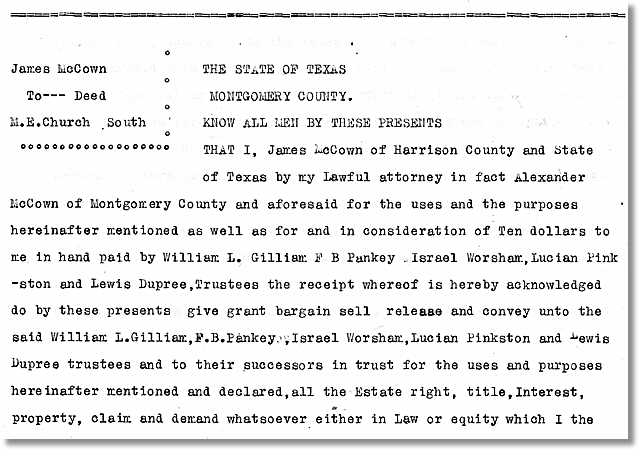
James McCown
* THE STATE OF TEXAS
To---
Deed
* MONTGOMERY COUNTY.
M.E.Church
South * A
LL MEN BY THESE PRESENTS
THAT I, James McCown of Harrison County
and State of Texas by my lawful attorney in fact Alexander McCown of
Montgomery County and aforesaid for the uses and the purposes hereinafter mentioned as well as for
and in consideration of Ten dollars to me in hand paid by William L. Gilliam F B Panky
Israel Worsham, Lucian Pinkston and Lewis Dupree, Trustees the receipt wherof is hereby acknowledged do by
these presents give grant bargain sell release and convey unto the said William L Gilliam, F. B.
Pankey, Israel Worsham, Lucian Pinkston and Lewis Dupree trustees and their successors in trust for the uses
and purposes hereinafter mentioned and declared, all the Estate right, title, Interest, property, claim and
demand whatsoever either in Law or equity which I the
Montgomery County Deed, Volume O, Page 384
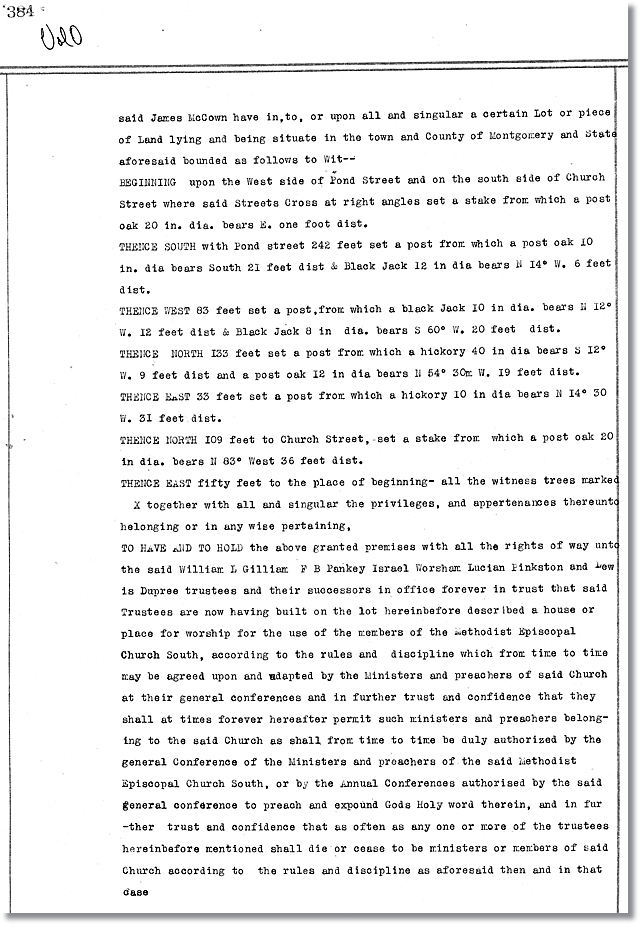
said Jame McCown have in, to, or upon all and singular a certain Lot or piece of land
lying and being situate in the town and County of Montgomery and State aforesaid bounded as
follows to wit--
BEGINNING upon the West side of Pond Street and on the south side of Church
Street where said Streets Cross at right angles set a stake from which a post oak 20 in. dia. bears E.
one foot dist.
THENCE SOUTH with Pond street 242 feet set a post from which a post oak 10 in. dia.
bears South 21 feet dist. & Black Jack 12 in dia bears 14
º W. 6 feet dist.
THENCE WEST 83 feet set a post , from which a black Jack 10 in dia. bears N
12
º W. 12 feet dist & Black Jack 8 in dia. bears S 60
º W. 20 feet dist.
THENCE NORTH 133 feet set a post from which a hickory 40 in dia bears 12
º W. 9 feet dist and post oak 12 in dia bears N 54
º 30m W. 19 feet dist.
THENCE EAST 33 feet set a post from which a hickory 10 in dia bears N 14
º 30 W. 31 feet dist.
THENCE NORTH 109 feet to Church Street, set a stake from which a post oak 20 in dia.
bears N 83
º West 36 feet dist.
THENCE EAST fifty feet to the place of beginning- all the witness trees marked X
together with all and singualr the privileges, and pertenances thereunto belonging or in any wise
pertaining,
TO HAVE AND TO HOLD the above granted premises with all the rights of way unto said
William L. Gilliam F B Pankey Israel Worsham Lucian Pinkston and Lewis Dupree trustees and
their successors in office forever in trust that said Trustees are
now having built on the lot hereinbefore described a house or place for worship for the use of the members
of the Methodist Episcopal Church South, according to the rules and discipline which from time to
time may be agreed upon and adapted by the Ministers and preachers of said Church at their general
conferences and in furhter trust and confidence that they shall at times forever hereafter permit such
ministers and preachers belonging to the said Church as shall from time to time be duly authorized by the
general Conference of the Ministers and preachers of the said Methodist Episcopal Church South, or by the
Annual Conference authorised by the said general conference to preach and expound Gods Holy word therein,
and in futher trust and confidence that as often as any one or more of the trustees hereinbefore mentioned
shall die or cease to be ministers or members of of said Church according to the rules and discipline as
aforesaid then and that case
Montgomery County Deed, Volume O, Page 385
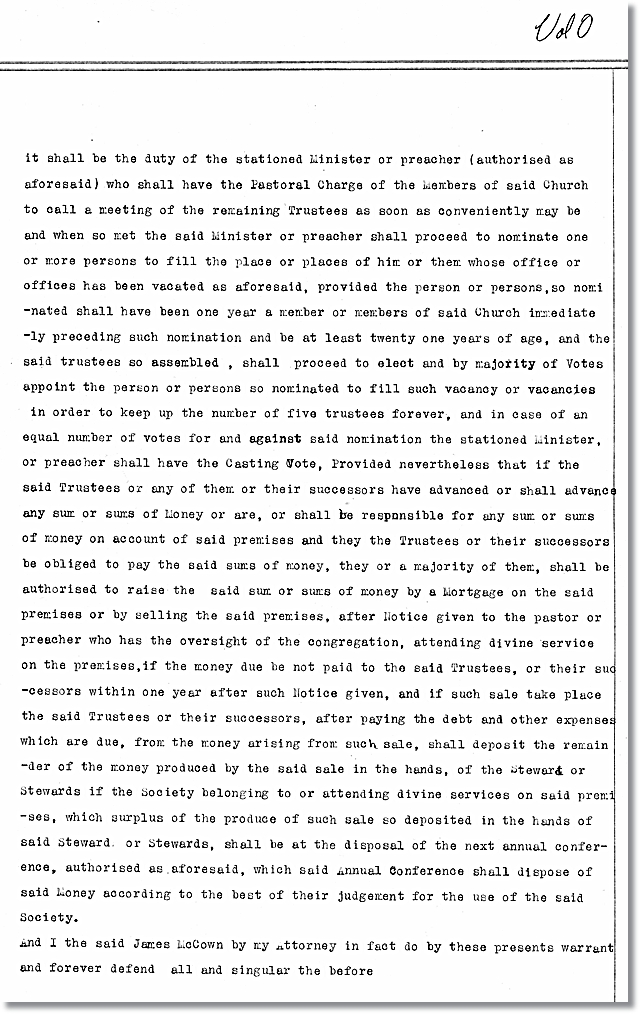
it shall be the duty of the stationed Minister or preacher (authorised as aforesaid)
who shall have the Pastoral Charge of the members of said Church to call a meeting of the remaining Trustees
as soon as conveniently may be and when so met the said Minister or preacher shall proceed to nominate one
or more persons to fill the place or places of him or them whose office or offices has been vacated as
aforesaid, provided the person or persons , so nominated shall have been one year a member or members of
said Church immediately preceding such nomination and be at least twenty one years of age, and the said
trustees so assembled , shall proceed to elect and by majority of Votes appoint the person or persons so
nominated to fill such vacancy or vacancies in order to keep up the number of five trustees forever, and in
case of an equal number of votes for and against said nomination the stationed Minister or preacher shall
have the Casting Vote, Provided nevertheless that if the said Trustees or any of them or their successors
have advanced or shall advance any sum or sums of Money or are, or shall be responsible for any sum or
sums of money on account of said premises and they the Trustees or their successors be obliged to pay the
said sums of money, they or a majority of them, shall be authorised to raise the said sum or sums of
money by a Mortgage on the said premises or by selling the said premises, after Notice given to the pastor
or preacher who has the oversight of the congregation, attending divine service on the premises, if
the money due be not paid to said Trustees, or their successors within one year after such Notice given, and
if such sale take place the said Trustees or their successors, after paying the debt and other expenses
which are due, from the money arising from such sale, shall deposit the remainder of the money produced by
the sale in the hands, of the Steward or stewards if the Society belonging to or attendung divine
services on said premises, which surplus of the produce of such sale so deposited in the hands of said
Steward or Stewards, shall be at the disposal of the next annual conference, authorised as aforesaid, which
said Annual Conference shall dispose of said Money according to the best of their judgement for the use of
the said Society.
And I the said James McCown by my attorney in fact do by these presents warrant and
forever defend all and singular the before
Montgomery County Deed, Volume O, Page 386
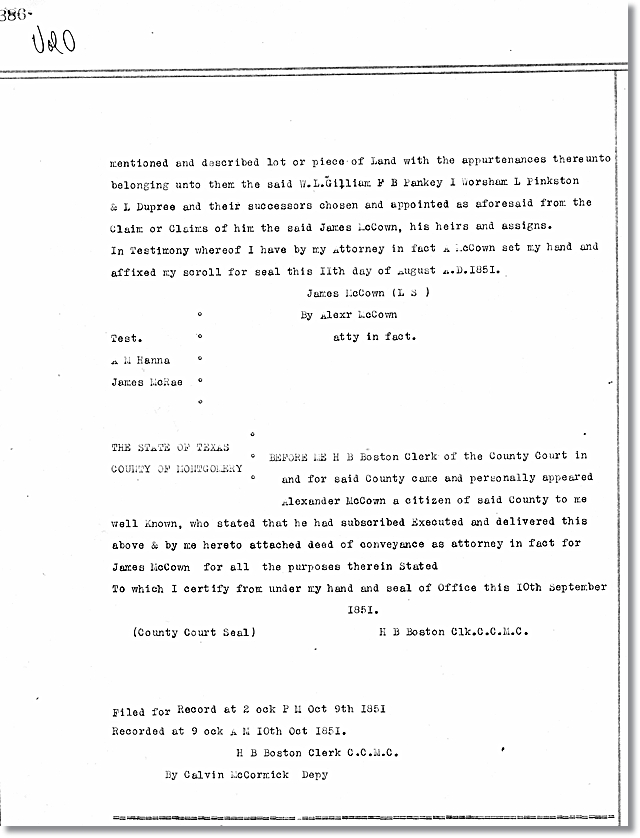
mentioned and sescribed lot or piece of Land with the appurtenances thereunto belonging
unto them the said W. L. Gilliam F B Pankey I Worsham L Pinkston & L Dupree and their
successors chosen and appointed as aforesaid from the Claim or Claims of him the said James McCown, his
heirs and assigns. In Testimony whereof I have by my Attorney in fact A McCown set my
hand and affixed my scroll for seal this 11th day of August
A.D.1851.
James McCown (L S )
By Alexr McCown
atty in fact.
*
Test.
*
A M Hanna *
James McRae *
*
THE STATE OF TEXAS
*
COUNTY OF MONTGOMERY *
BEFORE ME H B Boston Clerk of the County Court in and for said County came and personally appeared Alexander
McCown and personally appeared Alexander McCown a citizen of said County to me well known, who stated that
he had subscribed Executed and delivered this above & by me hereto attached deed of conveyance
as attorney in fact for James McCown for all the purposes therein Stated
To which I certify from under my hand and seal of Office this 10th
September
1851.
(County Court
Seal)
H B Boston Clk.C.C. M.C.
Filed for Record at 2 ock P M Oct 9th 1851
Recorded at 9 ock A M 10th Oct 1851
H B Boston Clerk C.C.M.C.
By Calvin McCormick Depy
See Montgomery County Deeds, Vol. O, pages 383-386. This deed refers to the
church the dedicated in July 0f 1851 where it records, "said Trustees are now having built on the lot
hereinbefore described a house or place for worship for the use of the members of the Methodist Episcopal Church
South"
This deed is also interesting in that it provides details regarding the early
organization of the church such as the number of Trustees and the procedure by which Trustee vacancies were to
be filled.
It is interesting to note that there was once a street called Church Street that
appears to have run between the property the Methodist Church was built on and the property the Baptist Church
was built on. I have not been able to determine when the street called Church Street ceased to run
between the two church buildings.
James McCown had purchased the town of Montgomery from W. W. Shepperd but did not live
there. James McCown's brother, Alexander McCown, did live in Montgomery and handled land transcations as
James McCown's "attorney in fact." See the 1845 advertisement from the Montgomery Patiot below
as example of Alexander McCown acting the Proprietor of the Town of Montgomery. Click here for some family history on the Interenet for James McCown and Alexander
McCown.
1845 Advertisement - Alexander McCown Proprietor
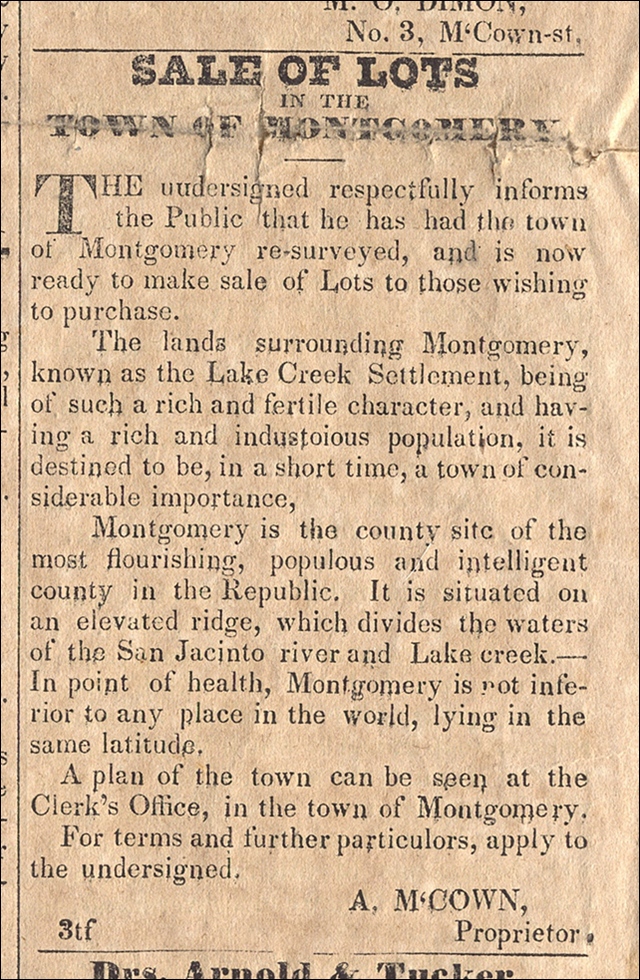
See the July 2, 1845 edition of the Montgomery Patirot, page 4, Special thanks
to Mac Woodward, Curator of Collections, with the Sam Houston Memorial Museum in Huntsville, Texas for this scan
of the "Town of Montgomery" advertisement found in the Montgomery Patriot newspaper.
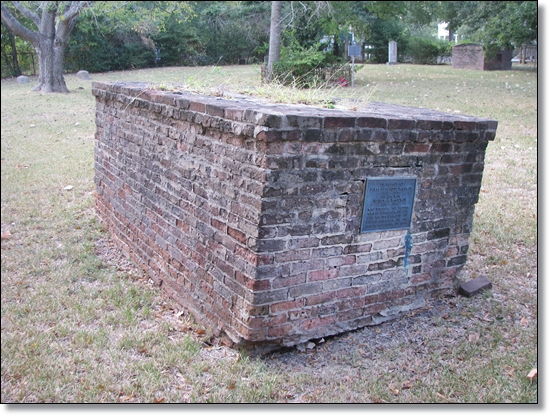
"McCown" Burial Vault in the "Old Cemetery" in Montgomery,
Texas.
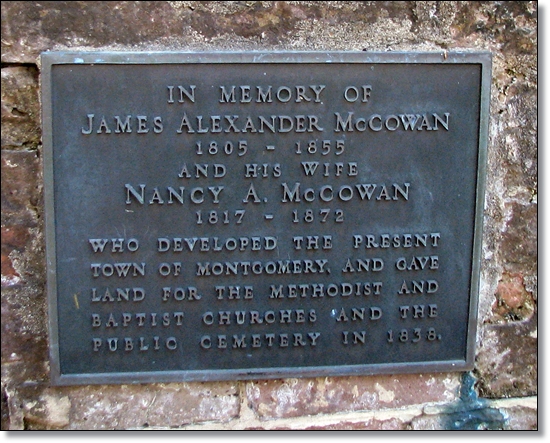
Plaque on Burial Vault
According to a Texas State Historical marker, James McCown also donated the land for
the Baptist Church in Marshall, Texas in 1849. James McCown is not buried in Montgomery,
Texas. He was buried in Marshal, Harrison County, Texas.
Someone attached a plaque to this burial vault and identified the deceased as James
Alexander McCown. As shown in the deed above, James McCown and his brother, Alexander McCown, were two
different people. James McCown had purchased the town of Montgomery from W. W. Shepperd in 1839 (the sale was
concluded in 1840). Alexander McCown was James McCown's agent (attorney-in-fact) in the town of
Montgomery. This is probably Alexander McCown's burial vault since he actually lived in Montgomery,
Texas.
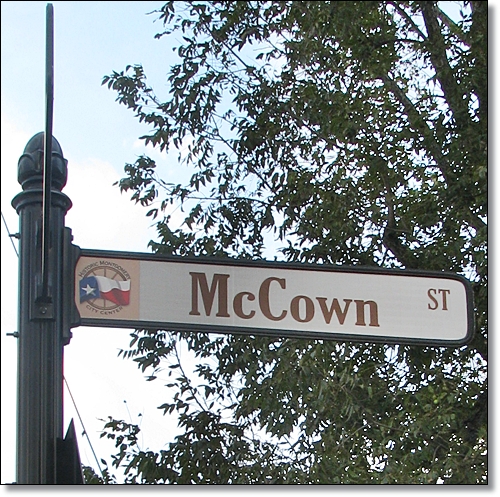
McCown St
The plaque does not appear to have been placed on the burial vault by a family member
as the name is misspelled. The McCown brothers spelled their name "McCown" and it is mispelled "McCowan" on
the plaque on the burial vault.
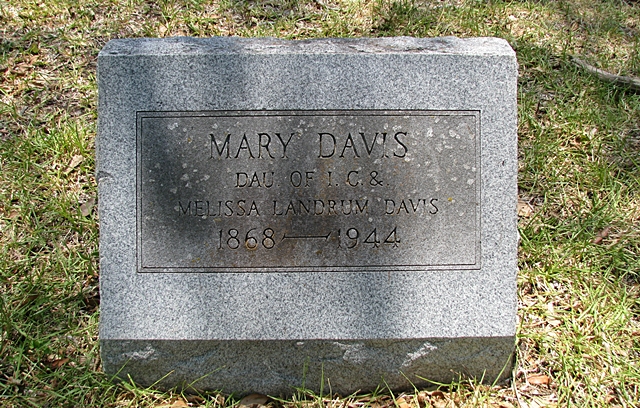
Headstone of Mary Davis (1868-1944) in the "Old Cemetery" in Montgomery,
Texas.
The deed does not seem to provide any specific details about the Methodist church
cemetery though the land description could very well include the land in the cemetery. The deed does not
mention the cemetery or the 1842 Methodist parsonage as such.
Photographs of "The Old Methodist Churchyard," Montgomery, Texas
Inscriptions from Old Methodist Church Cemetery, Montgomery , Texas
Link to the Montgomery United Methodist Church, Montgomery Texas today.
1 See references to Thomas Parmer (also as Palmer) in The Personal Correspondence of Sam
Houston, Volume I: 1839-1845, (1996, University of North Texas Press) by Madge Thornall Roberts; and The
Personal Correspondence of Sam Houston, Volume II: 1846-1848, (1998, University of North Texas Press) by Madge
Thornall Roberts.
On this page, we will add historical data pertinent to the history of the Methodist Church in
Montgomery, Texas.
The four most valuable sources to our research so far are Homer S. Thrall's
book, History of Methodism in Texas, published in Houston, Texas by E. H. Cushing in 1872; "The Texas
Methodist Historical Quarterly," Vol. 1, No. 3, published in Georgetown, Texas by the Texas Methodist
Historical Association in January 1910; and Macum Phelan's A History of Early Methodism in Texas
1817-1866, (1924, Nashville, Cokesbury).
We have had a chance to review this very significant primary document which
is still in existence. This document appears to be extremely valuable to a study of the early history of
the Montgomery Circuit and Montgomery Methodist church between 1839-1850. This document appears to have been
used many times throughout Macum Phelan's A History of Early Methodism in Texas 1817-1866, (1924,
Nashville, Cokesbury). Located in the Oscar Murray Addison Papers in the Dolph Briscoe Center for American History
at the University of Texas at Austin [formerly the Barker Texas History Center] in Box 2A 103 is the "Journal of
the church conference held at Montgomery 1839-1850." Oscar Murray Addison (1820-1898) was a Methodist minister in
Texas. He retired from the ministry in 1889 and settled on a farm in Eulogy, Texas in Somervell County where
he assembled a large collection of historical material concerning Texas Methodists. As previously stated, these
materials are located at the Dolph Briscoe Center for American History at the University of Texas at Austin.
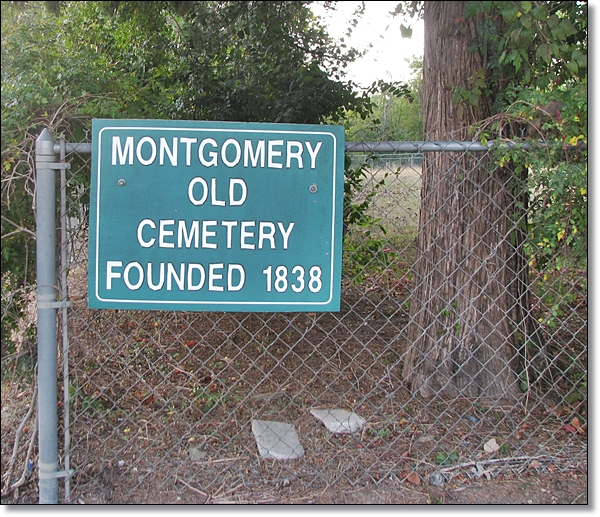
Another potentially important primary document is located in the Oscar Murray Addison
Papers in Box 2A 125. This is "Joseph P. Sneed's journal, 1839-1840." Following Strickland's assignment in
1838, Rev. Sneed was assigned to the Montgomery Circuit from 1839-1840. See details for Box 2A 103 and Box 2A
125 at: http://www.lib.utexas.edu/taro/utcah/00685/cah-00685.html.
It will be interesting to see if these documents provide any helpful information about the "Old
Cemetery" and/or early church members.
HELP WANTED: We are currently looking for any deeds, maps, plats or plots for the earliest
Methodist Church and the "Old Cemetery" in Montgomery, Texas. If you have copies of any of these documents,
please let us know. We are especially interested in documents concerning burials in the cemetery and the
first deed to the Methodist Church or its trustees for the land the cemetery and the first Methodist Church were
built on. Here, we will include as many details regarding the early history of the Methodist Church in
Montgomery, Texas and the cemetery as we unearth them. The goal is to develop the most complete history of the
church and cemetery that we can.
Kameron Searle
9111 Katy Fwy., Suite 202
Houston, Texas 77024
ksearle1@pdq.net
W# 713-880-4529
| 


































